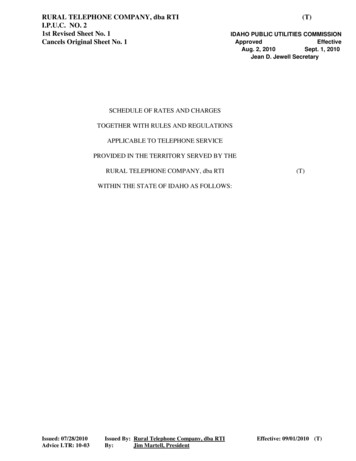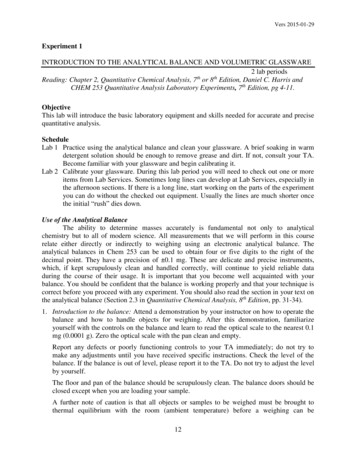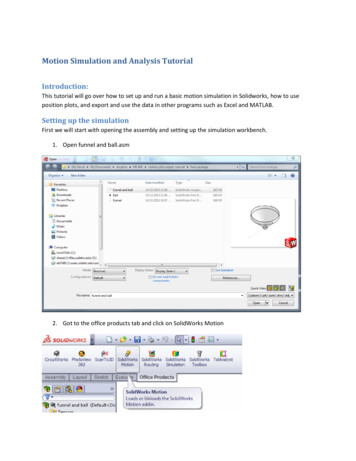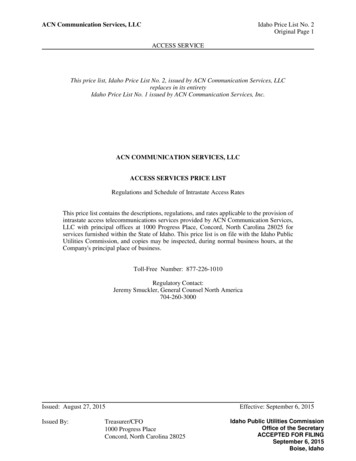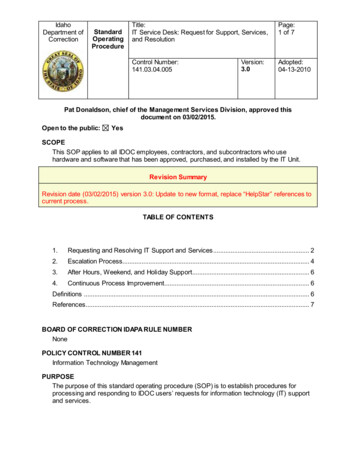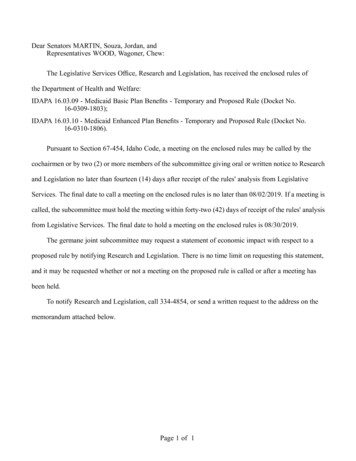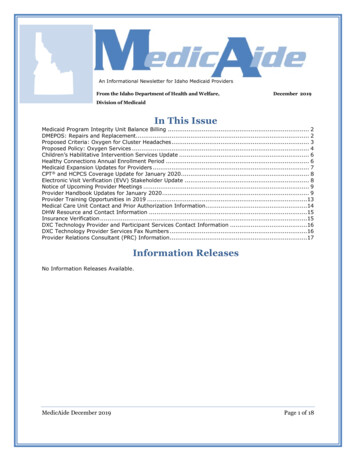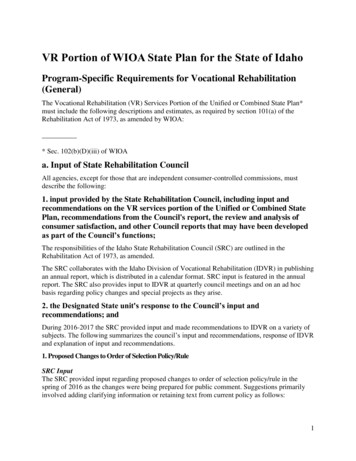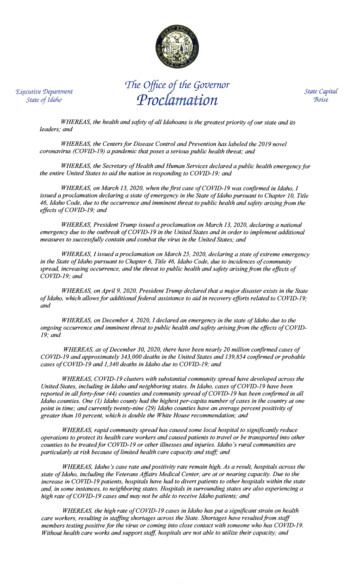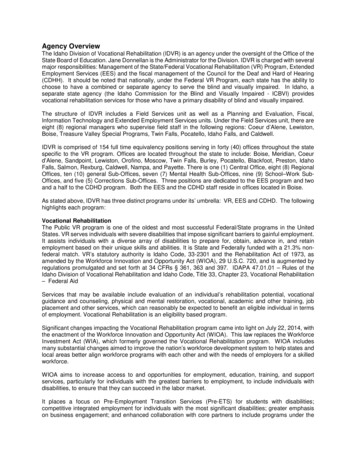
Transcription
Agency OverviewThe Idaho Division of Vocational Rehabilitation (IDVR) is an agency under the oversight of the Office of theState Board of Education. Jane Donnellan is the Administrator for the Division. IDVR is charged with severalmajor responsibilities: Management of the State/Federal Vocational Rehabilitation (VR) Program, ExtendedEmployment Services (EES) and the fiscal management of the Council for the Deaf and Hard of Hearing(CDHH). It should be noted that nationally, under the Federal VR Program, each state has the ability tochoose to have a combined or separate agency to serve the blind and visually impaired. In Idaho, aseparate state agency (the Idaho Commission for the Blind and Visually Impaired - ICBVI) providesvocational rehabilitation services for those who have a primary disability of blind and visually impaired.The structure of IDVR includes a Field Services unit as well as a Planning and Evaluation, Fiscal,Information Technology and Extended Employment Services units. Under the Field Services unit, there areeight (8) regional managers who supervise field staff in the following regions: Coeur d’Alene, Lewiston,Boise, Treasure Valley Special Programs, Twin Falls, Pocatello, Idaho Falls, and Caldwell.IDVR is comprised of 154 full time equivalency positions serving in forty (40) offices throughout the statespecific to the VR program. Offices are located throughout the state to include: Boise, Meridian, Coeurd’Alene, Sandpoint, Lewiston, Orofino, Moscow, Twin Falls, Burley, Pocatello, Blackfoot, Preston, IdahoFalls, Salmon, Rexburg, Caldwell, Nampa, and Payette. There is one (1) Central Office, eight (8) RegionalOffices, ten (10) general Sub-Offices, seven (7) Mental Health Sub-Offices, nine (9) School–Work SubOffices, and five (5) Corrections Sub-Offices. Three positions are dedicated to the EES program and twoand a half to the CDHD program. Both the EES and the CDHD staff reside in offices located in Boise.As stated above, IDVR has three distinct programs under its’ umbrella: VR, EES and CDHD. The followinghighlights each program:Vocational RehabilitationThe Public VR program is one of the oldest and most successful Federal/State programs in the UnitedStates. VR serves individuals with severe disabilities that impose significant barriers to gainful employment.It assists individuals with a diverse array of disabilities to prepare for, obtain, advance in, and retainemployment based on their unique skills and abilities. It is State and Federally funded with a 21.3% nonfederal match. VR’s statutory authority is Idaho Code, 33-2301 and the Rehabilitation Act of 1973, asamended by the Workforce Innovation and Opportunity Act (WIOA), 29 U.S.C. 720, and is augmented byregulations promulgated and set forth at 34 CFRs § 361, 363 and 397. IDAPA 47.01.01 – Rules of theIdaho Division of Vocational Rehabilitation and Idaho Code, Title 33, Chapter 23, Vocational Rehabilitation– Federal AidServices that may be available include evaluation of an individual’s rehabilitation potential, vocationalguidance and counseling, physical and mental restoration, vocational, academic and other training, jobplacement and other services, which can reasonably be expected to benefit an eligible individual in termsof employment. Vocational Rehabilitation is an eligibility based program.Significant changes impacting the Vocational Rehabilitation program came into light on July 22, 2014, withthe enactment of the Workforce Innovation and Opportunity Act (WIOA). This law replaces the WorkforceInvestment Act (WIA), which formerly governed the Vocational Rehabilitation program. WIOA includesmany substantial changes aimed to improve the nation’s workforce development system to help states andlocal areas better align workforce programs with each other and with the needs of employers for a skilledworkforce.WIOA aims to increase access to and opportunities for employment, education, training, and supportservices, particularly for individuals with the greatest barriers to employment, to include individuals withdisabilities, to ensure that they can succeed in the labor market.It places a focus on Pre-Employment Transition Services (Pre-ETS) for students with disabilities;competitive integrated employment for individuals with the most significant disabilities; greater emphasison business engagement; and enhanced collaboration with core partners to include programs under the
Department of Labor (Adult; Dislocated Workers; Youth and Wagner-Peyser) and Career TechnicalEducation (Adult Education and Literacy). This collaboration includes common performance reporting forall of the six core programs.The VR program has had significant accomplishments implementing the requirements under WIOA.Accomplishments include: expansion of supported employment services; representation on the WorkforceDevelopment Council (WDC); hiring a Business Liaison and Transition Coordinator; implementing Section511 to provide career counseling and information and referral to individuals with disabilities in or seekingsubminimum wage employment.WIOA has brought great opportunities, but there are also challenges. Our challenges are bothprogrammatic as well as fiscal. The Division must develop and implement programs differently then wehave historically been required with no additional funds. As stated, one significant new focus is (Pre-ETS)services to students with disabilities. The definition of a student with a disability has three components: Anage requirement; education program attendance; and disability. VR is required to shift 15% of its’ federalfunds to the provision of these services to students with disabilities. That equates to approximately 2.4million of VR’s total federal allocation.Additional fiscal and programmatic changes that will impact the VR program include: the implementationof customized employment services; changes to supported employment including the expansion of youthextended services; the costs associated with the infrastructure and operating costs for the American JobCenters; additional career counseling, information and referral services for individuals working insubminimum wage employment; benefits counseling; as well as the increased data sharing requirements.As a result of these programmatic changes there will be limitations on funds available to support servicesfor the non-student and adult population. If there are not sufficient funds, the VR program would need tocreate a waitlist for services, resulting in fewer individuals with disabilities returning to work, becoming selfsufficient and independent. There would be fewer individuals getting off public benefits and less state andother taxes paid.In summary, additional fiscal and programmatic impacts because of WIOA are anticipated. The impactswill have both a service delivery and personnel resource cost associated.Lastly, the VR program has had significant challenges in recruiting and retaining qualified vocationalrehabilitation counselors as a result of educational requirements and low wages.Extended Employment Services (EES)The EES program provides funding to individuals with severe disabilities who are deemed unable tomaintain employment without on-going support. The program provides skills development in a nonintegrated setting; or long term/on the job supports in community competitive employment for individualswith the most significant disabilities to include Traumatic Brain Injury, Developmental Disabilities, LearningDisabilities and individuals with chronic mental health issues. The EES program is 100% state Generalfunded. A state financial allotment is provided annually to be distributed by the EES Program Manager tocontracted Community Rehabilitation Programs (CRPs) who subsequently provide the long-term supportto eligible customers (IDAPA 47.01.02 Rules and Minimum Standards Governing Extended EmploymentServices under the authority of Idaho Code 33-2303).Council for the Deaf and Hard of Hearing (CDHH)CDHH is an independent agency. This is a flow-through council for budgetary and administrative supportpurposes only with no direct programmatic implication for IDVR. (Idaho Code, Title 67, Chapter 73, IdahoState Council for the Deaf and Hard of Hearing 67-7301 – 67-7308).Leading up to 1991, a group of concerned stakeholders agreed that centralized, state-level coordination ofdeaf and hard of hearing services was lacking in Idaho. They formed a task force, wrote a charter, lobbiedthe Legislature, and received funding. The Council was approved by the Legislature shortly thereafter.
The CDHH Board includes two persons who are deaf, two who are hard of hearing, a parent of a deaf child,a parent of a hard-of-hearing child, an audiologist, a medical doctor, and a sign language interpreter. TheBoard sets annual priorities and determines strategic direction. The Board also consists of eleven ex-officiomembers who represent various state agencies and organizations that have a stake in issues relating todeafness and hearing loss. The Executive Director and staff administer programs and daily operations.By statute, the Council is responsible to increase awareness, advocate for equal access, provideinformation and referral, monitor consumer protection, recommend public policies and programs, conductresearch, and submit reports to the Governor and policymakers.Major Accomplishments over the last 4 years include: The Department of Motor Vehicles throughout thestate now provide “the written” driving test in American Sign Language. Public Video phone is installed inCDHH offices to provide deaf and hard of hearing individuals access to telephone communications. Wepartnered with Idaho Department of Labor to provide Work Readiness Camps for Deaf and Hard of Hearingstudents as well as partnering with the Idaho Registry of Interpreters for the Deaf to sponsor workshopsand trainings to Sign Language Interpreters. We also partnered with Idaho Educational Services for theDeaf and the Blind to provide camps for deaf and hard of hearing students and published “Findings andRecommendations for Provisions of Mental Health Services to Idaho Citizens Who are Deaf or Hard ofHearing”.Legislative accomplishments are: RE 23765: Income tax Credit/Charitable Contributions (tax credit up to 500 for contributions to CDHH) and HB46: Sign Language Licensing Bill: Signed into law March 2017,effective 2018, all practicing Sign Language Interpreters must now be licensed in Idaho.In closing, CDHH Priorities are: Research on access and barriers to healthcare among deaf users of ASL(in partnership with Idaho State University, to reinstate Medicaid coverage for hearing aids for adults,promoting awareness of Sign Language Interpreter Licensure requirements to business/governmententities and community, and establishing a Telecommunications Equipment Distribution Program for Idaho.
Idaho Division of Vocational Rehabilitation Organizational Chart(As of 6/13/2018)Governor C "Butch" Otter 126,302Jane DonnellanDivisionAdministrator 112,674Steven SnowCDHH Director 70,845Nanna Hanchett DeputyAdministrator 106,038Shannon PurvisEES ProgramManager 68,640VacantFiscal Manager 78,146Roxanne EgelandRegion 1RegionalManager 70,907Teresa PittPlanning and EvaluationManager 84,864Stephen DeboardI.T. Resource Manager 77,418Max SorensonRegion 2RegionalManager 70,200Alan AamodtRegion 3RegionalManager 73,237VacantRegion 4Regional Manager 64,626Darrell QuistChief of Field Services 86,590Toni ZieglerRegion 5RegionalManager 72,405John OroseRegion 6Regional Manager 81,120Nancy RileyRegion 7RegionalManager 72,904Stephanie BowlesRegion 8Regional Manager 68,016
Statutory Authorityfor Programs under theIdaho Division of Vocational RehabilitationIdaho Division of Vocational Rehabilitation Idaho Code, Title 33, Chapter 23, Vocational Rehabilitation – Federal s/statutesrules/idstat/Title33/T33CH23.pdf IDAPA 47.01.01 – Rules of the Idaho Division of Vocational urrent/47/470101.pdfExtended Employment Services (EES) Idaho Code, Title, 33, Chapter 22, vocational Education – Federal Aid, /idstat/Title33/T33CH22/SECT33-2211/ Idaho Code, Title, Chapter 23, Vocational Rehabilitation- Federal Aid, /idstat/Title33/T33CH23/SECT33-2303/ IDAPA 47.01.02 – Rules and Minimum Standards Governing ExtendedEmployment /47/470102.pdfCouncil for Deaf and Hard of Hearing: Idaho Code, Title 67, Chapter 73 - Idaho State Council for the Deaf and Hard ofHearing, ds/statutesrules/idstat/Title67/T67CH73.pdf
Non-Classified Employee's SalariesQueried from Employee Personnel GroupNON CLASSIFIEDEMPLOYEE NAME: Ascending orderEMPLOYEE NAMEAAMODT, ALAN R.ALLEN, DEBORAH M.ARMSTRONG, STACI L.BAKER, LEAFY M.BARKER, BRIAN C.BARKER, DEBORAH M.BELL, TRACI A.BISHOP, ROBERTA L.BLOXHAM, LYLE L.BOWLES, STEPHANIE J.BURKE, AARICA L.CILLEY, KRISTAL S.CLAPP, DOUGLAS C.CLAYTON, ANN M.CLAYTON, CARYNCOBLER, MIKAYLACOLONEL, CAROL A.CONDEL, BROOKE A.CULVER, BRENT H.CUSHING, CAMERONDALE, LORRI A.DAVID, ELIZABETH A.DAVISON, JOHNATHAN E.DEBOARD, STEPHEN J.DONNELLAN, JANE W.DOSHIER, PEGGY M.EDMUNDS, JESSICA E.EGELAND, ROXANNE E.FLYNN, EMILY C.FOUTZ, CAROLGILL HADDEN, SHEILA A.GORDON, MELINDAGREY, ANDREW S.GUERRA, JUAN M.HANCHETT, NANNA G.CLASS CODE TITLEANNUAL EQUIVALENTSALARYREGIONAL MANAGERREHAB COUNSELOR IIREHAB COUNSELOR IIREHAB COUNSELOR IIREHAB COUNSELOR IIIREHAB COUNSELOR IIIREHAB COUNSELOR IIREHAB COUNSELOR IIIREHAB COUNSELOR IIIREGIONAL MANAGERREHAB COUNSELOR IIHUMAN RESOURCE SPECREHAB COUNSELOR IIIREHAB SPECIALISTREHAB SPECIALISTREHAB SPECIALISTREHAB COUNSELOR IIIREHAB COUNSELOR IIIREHAB COUNSELOR IIREHAB SPECIALISTREHAB COUNSELOR IIREHAB COUNSELOR IIIT SYS INTGR ANALYSTIT RESOURCE MGRADMINISTRATORREHAB COUNSELOR IREHAB SPECIALISTREGIONAL MANAGERREHAB COUNSELOR IIREHAB SPECIALISTREHAB COUNSELOR IIIREHAB COUNSELOR IPROGRAM ANALYSTREHAB COUNSELOR IIIVOC REHAB DEPUTY .6061,297.60106,038.40
HANKA, LONI F.HARRIS, MAILEHART IV, JOHN N.HAUGEN-MESSMER, HEATHER M.HOARD, DANIEL J.HOLLIBAUGH, LAURI A.IRETON, KENT A.JAMES, ERIN D.JENSEN, MATTHEW L.JOHNSON, JAYNES M.JONES, BRIAN A.LIBERTY, JENNIFER L.LIJEWSKI, CYNTHIA L.LOWENTHAL, DARCY A.LUKEHART, SHANDRAYMACGUFFIE, MICHAELMARKVE, MATTHEW E.MATTEI, VICTORIEMAXWELL, AMBERMCCALL, ALEXANDRA M.MCLEOD, LISA A.MILEY, DOUGLAS L.MORAN, ANGELAMUNKRES, THERESA L.MURILLO, ANGELENENIELSON, KARANOBLE, LAUREN N.NUNEZ, YANETOROSE, JOHNPENA, JARHEDPERNER, DEBBIE S.PITT, TERESA L.PRICE JR, ROBERT C.QUIST, DARRELL I.REDFORD, GARYRICHARDSON, TARARILEY, NANCY Z.ROEPER, JOSHUA E.VACANTSCHNEIDER, JACQUELINESHARP, JODIE L.SIDWELL, ROBERT O.SNOW, STEVEN L.SORENSON, MAX M.SWINDLER, DOUGLAS N.BUSINESS SPECIALISTREHAB SPECIALISTREHAB SPECIALISTREHAB COUNSELOR IIIIT PRGRMR ANALYST, SRREHAB SPECIALISTREHAB COUNSELOR IIIREHAB COUNSELOR IIREHAB COUNSELOR IIIREHAB COUNSELOR IIREHAB COUNSELOR IIIREHAB COUNSELOR IIIREHAB COUNSELOR IIIPROGRAM MANAGERREHAB COUNSELOR IREHAB COUNSELOR IIPROGRAM EVALUATIONANALYSTREHAB SPECIALISTREHAB COUNSELOR IREHAB COUNSELOR IREHAB COUNSELOR IIFINANCIAL SPECIALIST, SRREHAB COUNSELOR IREHAB COUNSELOR IIIREHAB SPECIALISTREHAB COUNSELOR IREHAB COUNSELOR IIREHAB COUNSELOR IREGIONAL MANAGERREHAB COUNSELOR IREHAB COUNSELOR IIPLAN & EVAL MGRREHAB COUNSELOR IICHF-BUR OF FIELD SERVSREHAB COUNSELOR IIREHAB COUNSELOR IIIREGIONAL MANAGERREHAB SPECIALISTFINANCIAL MANAGERREHAB COUNSELOR IREHAB SPECIALISTREHAB COUNSELOR IIIEXDIR/CNCL DEAF&HARD-O-HREGIONAL MANAGERREHAB COUNSELOR ,393.60
THIBAULT, DENNIS P.THOMPSON, CASEY L.TIBBETTS, CALEB B.WEAVER, MARK A.WHITE, DAVID D.WHITING, SUZETTE K.WHITMER, DENNIS L.WILCOX, SHANNON R.WILLIAMS, LAMISSEWILSON, DAVIDWOOD, DAVID M.WRIGHT, CHRISTOPHERZIEGLER, TONI S.VACANTVACANTVACANTVACANTVACANTVACANTJun 13, 2018REHAB COUNSELOR IIIREHAB COUNSELOR IIIREHAB SPECIALISTFINANCIAL SPECIALISTREHAB COUNSELOR IIREHAB COUNSELOR IIIREHAB COUNSELOR IIPROGRAM MANAGERREHAB SPECIALISTREHAB COUNSELOR IREHAB SPECIALISTREHAB COUNSELOR IREGIONAL MANAGERREGIONAL MANAGERREHAB COUNSELOR IREHAB COUNSELOR IREHAB COUNSELOR IREHAB COUNSELOR IREHAB COUNSELOR ,348.8042,348.8042,348.8011:31:33 AM
AGENCY VRIDVRIDVRIDVRIDVRAA0SAFTE3PROPERTY ADDRESS490 Maple St1859910200 W Emerald1600 Park Ave2025 W Park Place1825 Hoopes Ave529600 Watertower505 N Main St1018 W Sanetta St21416 Johnson Ave29 N Main8232281070 Hiline Rd30 S State155 W Main St1301 Main St102 S Euclid Ave650 Addison Ave WSuite/UnitSte BStes 101and 102Ste A13Ste 1010Stes B andC00Stes 16‐180Stes 200and 2200Ste 3Ste 3ASte 211Ste 102IDVR12 Len B. Jordan Building1st floorIDVR10 Len B. Jordan Building1st floorIDVR0 Len B. Jordan Building1st floorIDVR5 Borah Building4th floorIDVR7 Lewiston3rd flooro allow for office we have through MOAs and school agreements/jtPROPERTY CITYLESSOR NAMEBlackfoot Manwaring Investments LLCBoiseBurleyCoeur d AleneId FallsAmeritel LLCCSIGary AdkinsonBDS LLCMeridian Honor Park, LLCMoscow Disability Action Center‐NW IncNampa Schmidt Investments LPOrofino Paul PippengerPayette James and Janice M McCuePocatelloPrestonRexburgSalmonSandpointTwin FallsBoiseBoiseBoiseBoiseLewistonHorizon of PocatelloFoster PropDwight and Regina HillKeith BernhardtSandpoint Event CenterTwin Falls CoState OwnedState OwnedState OwnedState OwnedState ‐15Sep‐97May‐90Aug‐20 Sep‐18Mar‐18 Jan‐00Aug‐20 Jan‐00Apr‐20 Nov‐16 Oct‐21 Nov‐18Apr‐03 Mar‐19 1,156 84,38413,18833,50036,05900JJ1,290 585 3,580 16.88 18.12 13.66 21,77510,60048,90300J646 571 15.16 12.61 JU,JE, J02,9781,871751,1851,772 16.4312.0016.7515.61RENT/YREXC15,294J 0 2,8992,2006924015002,782 /SF13.23 13.586.3114.8213.8012.6511.00 10.70 10.70 10.70 10.88 11.24 31,864.60 20,019.70 802.50 12,892.80 19,917.28 85,496.88COMMENTSCOSTRATIO0.83 9/18 16.90, 9/19 17.3600 5/19 15.92 2/19 17.22, 2/20 17.56,2/21 17.91, 2/22 18.270 2/19 13.93; 2/20 14.21 11/18 15.46; 11/19 15.77;11/20 16.0900.791.070.890.72 7/18 13.99, 7/19 14.41 1/19 6.9600CPI 3/14 Base00.993.340.700.971.041.44Main OfficeIT & Fiscal DepartmentsServer RoomEES Program and VR OfficeLewiston Regional Office0.790.721.010.991.15
The Idaho Division of Vocational Rehabilitation (IDVR) is an agency under the oversight of the Office of the State Board of Education. Jane Donnellan is the Administrator for the Division. IDVR is charged with several . BAKER, LEAFY M. REHAB COUNSELOR II 50,107.20 BARKER, BR

